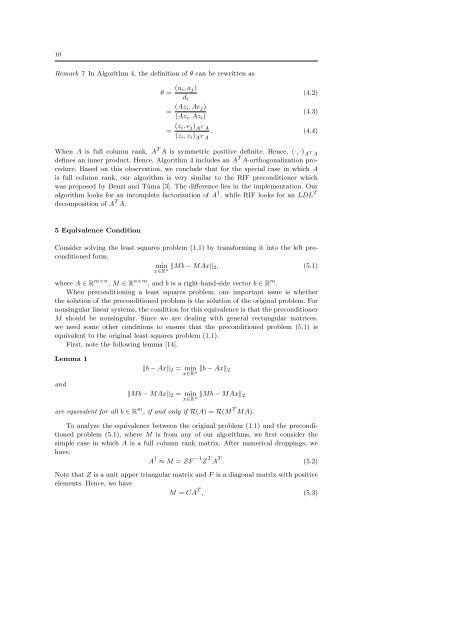Greville's Method for Preconditioning Least Squares ... - Projects
Greville's Method for Preconditioning Least Squares ... - Projects
Greville's Method for Preconditioning Least Squares ... - Projects
You also want an ePaper? Increase the reach of your titles
YUMPU automatically turns print PDFs into web optimized ePapers that Google loves.
10<br />
Remark 7 In Algorithm 4, the definition of θ can be rewritten as<br />
θ = (u i, a j )<br />
d i<br />
(4.2)<br />
= (Az i, Ae j )<br />
(Az i , Az i )<br />
(4.3)<br />
= (z i, e j ) A T A<br />
. (4.4)<br />
(z i , z i ) A T A<br />
When A is full column rank, A T A is symmetric positive definite. Hence, (·, ·) A T A<br />
defines an inner product. Hence, Algorithm 4 includes an A T A-orthogonalization procedure.<br />
Based on this observation, we conclude that <strong>for</strong> the special case in which A<br />
is full column rank, our algorithm is very similar to the RIF preconditioner which<br />
was proposed by Benzi and Tůma [3]. The difference lies in the implementation. Our<br />
algorithm looks <strong>for</strong> an incomplete factorization of A † , while RIF looks <strong>for</strong> an LDL T<br />
decomposition of A T A.<br />
5 Equivalence Condition<br />
Consider solving the least squares problem (1.1) by trans<strong>for</strong>ming it into the left preconditioned<br />
<strong>for</strong>m,<br />
min ‖Mb − MAx‖ 2, (5.1)<br />
x∈R n<br />
where A ∈ R m×n , M ∈ R n×m , and b is a right-hand-side vector b ∈ R m .<br />
When preconditioning a least squares problem, one important issue is whether<br />
the solution of the preconditioned problem is the solution of the original problem. For<br />
nonsingular linear systems, the condition <strong>for</strong> this equivalence is that the preconditioner<br />
M should be nonsingular. Since we are dealing with general rectangular matrices,<br />
we need some other conditions to ensure that the preconditioned problem (5.1) is<br />
equivalent to the original least squares problem (1.1).<br />
First, note the following lemma [14].<br />
Lemma 1<br />
and<br />
‖b − Ax‖ 2 = min<br />
x∈R n ‖b − Ax‖ 2<br />
‖Mb − MAx‖ 2 = min<br />
x∈R n ‖Mb − MAx‖ 2<br />
are equivalent <strong>for</strong> all b ∈ R m , if and only if R(A) = R(M T MA).<br />
To analyze the equivalence between the original problem (1.1) and the preconditioned<br />
problem (5.1), where M is from any of our algorithms, we first consider the<br />
simple case in which A is a full column rank matrix. After numerical droppings, we<br />
have,<br />
A † ≈ M = ZF −1 Z T A T . (5.2)<br />
Note that Z is a unit upper triangular matrix and F is a diagonal matrix with positive<br />
elements. Hence, we have<br />
M = CA T , (5.3)

















